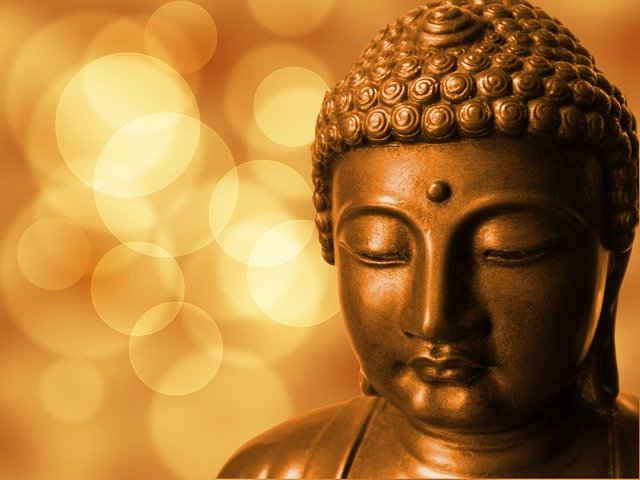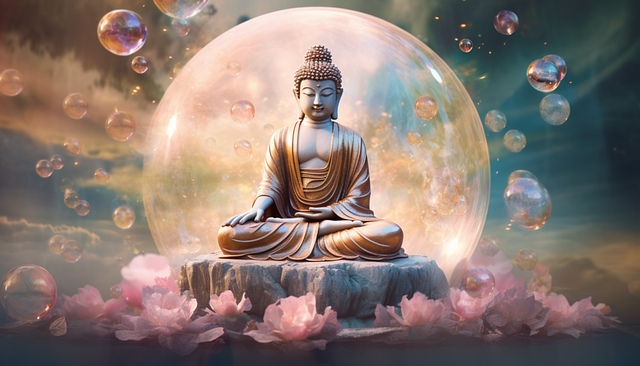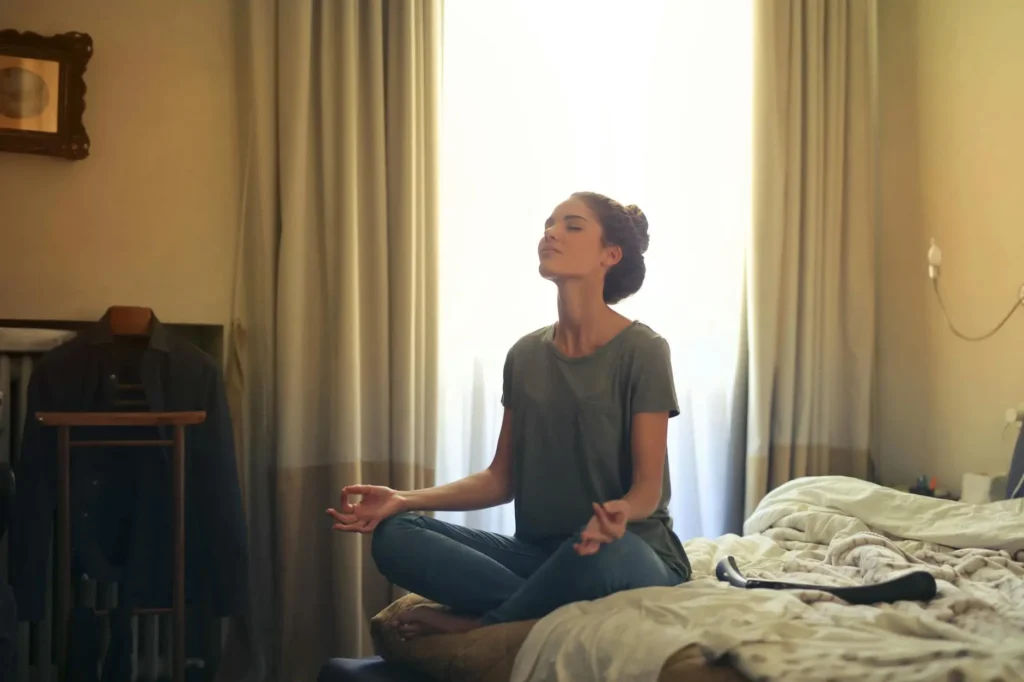
How To Understand Three Dynamic Buddhist Meditation Techniques
Introduction
Meditation is vast and varied, with roots stretching back thousands of years, touching nearly every culture and spiritual tradition. From the ancient Vedic texts of India to the mindfulness movements of today, meditation has evolved, but the core goal remains the same: to quiet the mind and delve into the depths of the inner self.
Meditation offers mental clarity, emotional calm, and physical relaxation. This post explores three distinct meditation practices: Mindfulness Meditation, Transcendental Meditation, and Zen Meditation. Each technique has unique elements and benefits, making them suitable for different preferences and lifestyles.
Buddhist meditation uses mindfulness to focus on an object, thought, or activity—such as training their attention and awareness—for mental clarity, emotional calmness, and stability in the world around them. Practicing meditation has been in cultures worldwide for thousands of years.
Buddhist meditation is a diverse array of spiritual practices used in the Buddhist tradition to develop mindfulness, concentration, tranquility, and insight. Rooted in the teachings of Siddhartha Gautama, known as the Buddha, who lived and taught in northeastern India between the 6th and 4th centuries BCE, these practices are central to Theravada, Mahayana, and Vajrayana forms of Buddhism.
The Ancient Roots of Meditation: Tracing Back its Origin
Meditation’s history is as fascinating as it is deep. Originally conceived as a method to understand life’s sacred and mystical forces, it has now become a tool for relaxation and stress reduction in the modern world.
Meditation in the Modern Day: More Than a Trend
These days, you’re as likely to hear about meditation in a corporate wellness program as you are in a spiritual retreat. This widespread adoption speaks to its universal benefits that all can access, regardless of background or beliefs.
The Spectrum of Buddhist Meditation Practices
Buddhist meditation takes many forms, but today, we focus on three, each offering its distinct focus and techniques. The “Spectrum of Meditation Practices” refers to the wide range of meditation techniques and styles across different cultures, traditions, and purposes. These practices vary in approach, focus, and intended outcomes, offering many options for individuals seeking mental, emotional, and spiritual benefits.
The Basic Principle: Understanding Mindfulness and Awareness
“The Basic Principle: Understanding Mindfulness and Awareness” refers to the foundational concept behind many meditation and psychological practices, particularly mindfulness meditation. This principle revolves around cultivating a heightened state of being aware of and attentive to the present moment without judgment or distraction. Meditation is about Mindfulness, which refers to the practice of being deliberately aware of each present moment without judgment or bias.

Mindfulness, Transcendental, and Zen Meditation offer unique approaches to seeking peace and clarity. By understanding the nuances of each practice, you can choose the one that best fits your needs and lifestyle. Experiment with each technique to understand its potential benefits and find your path to mindfulness.
Mindfulness Meditation focuses on being intensely aware of what you’re sensing and feeling in the moment without interpretation or judgment. It involves breathing methods, guided imagery, and other practices to relax the body and mind and help reduce stress.
It’s the feelings you get from being fully present with your experiences without getting lost. Think of it as observing your thoughts and feelings as they are without trying to change them.
From mindful eating to walking meditation, mindfulness can be woven into the fabric of our everyday lives, transforming routine tasks into moments of deep meditation.
How to Practice:
- Sit comfortably with your back straight.
- Pay close attention to your breathing or to a sensory experience, like sound.
- When distractions occur, gently return your focus to your breath or senses.
Benefits:
- Reduces stress and anxiety.
- Enhances focus and concentration.
- Promotes emotional health and well-being.
Transcendental Meditation is a simple, natural technique practiced 20 minutes twice daily while sitting comfortably with closed eyes. Its mantra defines it, and it is known for reducing stress and improving well-being. Studies have shown Transcendental Meditation can reduce stress and anxiety, improve heart health, and enhance creativity and productivity.
How to Practice:
- Sit in a comfortable and quiet place.
- Close your eyes and silently repeat a personally assigned mantra, such as a word, sound, or small phrase.
- Passively allow thoughts to come and go, returning to the mantra.
Benefits:
- Reduces stress and anxiety.
- Supports overall health.
- Enhances self-awareness and self-regulation.
Zen Meditation (Zazen)
Zen Meditation is one of the central practices of Zen Buddhism and serves as its core meditative practice. Translating literally into English would mean sitting meditation. This meditation involves observing thoughts and sensations without attachment as they pass through the mind and body.
Zazen, or sitting meditation, is the heart of Zen practice. It emphasizes simplicity and observation of the mind. Sitting straight back, legs crossed, and attention anchored to your breath or a question, Zazen quiets the mind and fosters insight.
How to Practice:
- Sit on the floor on a cushion, with legs crossed and hands folded comfortably.
- Focus on your breath, counting breaths if necessary.
- Maintain a posture that is upright and stable.
Benefits:
- Increases ability to concentrate.
- Enhances clarity and insight.
- Promotes a deeper understanding of one’s nature.
Comparing the Techniques
While all three practices aim at developing mindfulness and reducing stress, they each have their methodologies and focal points. Mindfulness Meditation is widely adaptable, focusing on awareness. Transcendental Meditation uses a mantra for achieving a state of relaxed awareness. Zen Meditation combines the posture, breathing, and mindset to find stillness.
Physical and Mental Dynamic Buddhist Meditation Technique Benefits
The benefits of meditation are well-documented and profound. They impact nearly every aspect of the human experience. Meditation is a multifaceted practice with numerous techniques that provide wide-ranging benefits. When discussing “Physical and Mental Diverse Meditation Technique Benefits,” we can focus on specific aspects such as stress reduction, immune boost, and emotional well-being, each critical to maintaining a balanced and healthy life.
Here’s how meditation can positively impact these areas:
Stress Reduction: The Relaxation Response
Meditation activates the body’s relaxation response, helping to decrease blood pressure, heart rate, and muscle tension. Meditation is perhaps most widely recognized for its ability to reduce stress. Stress is a common reaction to the demands of modern life, but chronic stress can lead to serious health problems, including heart disease, diabetes, depression, and a weakened immune system.
- Mechanism: Meditation helps reduce stress by improving the regulation of stress hormones like cortisol produced by the adrenal glands. Techniques such as mindfulness meditation encourage practitioners to focus on the present moment, which can prevent stress-inducing rumination and anxiety about past or future events.
- Benefits: Regular meditation decreases the physiological triggers of stress and the flight-or-fight response, promoting a calmer and more relaxed state. Meditation can lead to better sleep, reduced blood pressure, and overall calm and control over one’s environment.
Immune Boost: Fighting Off Illness
Regular practice is linked to a more robust immune system, which better equips you to fight colds and flu. A strong immune system helps the body fight infections and disease. Meditation can benefit the immune response, enhancing the body’s ability to prevent illness.
- Mechanism: Meditation can positively affect the immune system by reducing stress and enabling the body to allocate resources towards maintenance and healing. For instance, mindfulness meditation has increased the activity of natural killer cells, crucial for combating infections and cancerous cells.
- Benefits: Meditation can boost the immune system, helping to protect against colds, flu, and other infections. Improved immune function can also contribute to better overall health and vitality.
Emotional Well-being: Anxiety and Depression Management
Meditation can be a powerful ally in managing symptoms of anxiety and depression, offering a sense of calm and control. Emotional well-being is necessary for good health and happiness. Meditation supports emotional health in several ways, making it easier to experience positive emotions, enjoy life, and handle adversity.
- Mechanism: Meditation practices, especially those that involve mindfulness or loving-kindness, encourage an awareness and acceptance of one’s feelings without judgment. This awareness helps individuals recognize and manage negative emotions like anger, jealousy, or fear.
- Benefits: Regular meditation practitioners often report higher levels of happiness and contentment as they become more adept at managing emotions. Meditation can also decrease symptoms of depression and anxiety and will improve self-esteem and self-acceptance.

Long-term Diverse Buddhist Meditation Benefits That Last a Lifetime
Long-term Diverse Meditation Benefits That Last a Lifetime” refers to the enduring and varied advantages that regular meditation can offer throughout a person’s life. Meditation isn’t just a short-term solution for calming the mind or temporarily reducing stress; it has profound, lasting benefits that can enhance many aspects of physical, mental, and emotional health.
The “Long-term Diverse Meditation Benefits That Last a Lifetime” can significantly influence various aspects of a person’s life, including personality and behavioral changes, relationship improvement, and overall life satisfaction and happiness.
Let’s explore how meditation facilitates these benefits:
Personality and Behavioral Changes: Shifting Habits
Meditation leads to personal growth and development, influencing how we relate to the world. Meditation also affects your personality and behavior over time. Regular meditation is associated with increased self-awareness, the foundation for meaningful personality changes.
- Increased Emotional Regulation: Meditation enhances the ability to manage and respond to emotions in a healthy way. This can lead to decreased impulsivity and increased patience, kindness, and empathy.
- Reduction in Negative Traits: Practices like mindfulness can decrease levels of neuroticism, which is often linked with high levels of stress and emotional instability. As individuals become more adept at handling stress, they typically exhibit less anxiety and moodiness.
- Promotion of Positive Traits: Meditation can boost traits like openness to experience and conscientiousness, fostering a willingness to try new things and a better ability to maintain organized and goal-oriented behaviors.
Relationship Improvement: Fostering Compassion and Understanding
Increasing compassion with meditation creates deeper connections to others, enriching personal and professional relationships. The changes brought about by meditation naturally extend to interpersonal relationships. By fostering improved communication skills, meditation can enhance the quality of both personal and professional relationships.
- Enhanced Empathy and Understanding: Meditation increases the capacity for empathy, allowing individuals to better understand and relate to the feelings of others. This understanding can improve communication and reduce conflicts.
- Improved Listening Skills: Mindfulness meditation improves one’s ability to be present, which enhances listening skills. Being a good listener is crucial for all successful relationships.
- Greater Emotional Resilience: With better stress management and emotional regulation, meditators can handle relationship challenges with more calmness and less reactivity, contributing to more stable and harmonious relationships.
Life Satisfaction and Happiness: Nurturing Contentment
Regular practitioners often report higher levels of life satisfaction and happiness, finding contentment in the simplicity of being. Meditation improves life satisfaction and happiness by changing how one experiences and interacts with the world.
- Increased Presence and Enjoyment: Meditation teaches practitioners to live in the moment, which can increase the enjoyment of life’s activities and lead to greater life satisfaction.
- Reduction of Stress and Anxiety: By reducing stress and anxiety, meditation can remove significant barriers to happiness. Lower stress levels are directly correlated with increased happiness and contentment.
- Connection to a Larger Purpose: Many people find that meditation helps them feel connected to something larger than themselves, whether it’s a community, nature, or spiritual practice. This connection can enhance feelings of well-being and fulfillment.
Cognitive Perks: Sharpening Diverse Meditation Through Stillness
Concentration and Focus: The Mental Gymnastics
Like any skill, focus improves with practice. Meditation is that practice for the mind. Concentration refers to the ability to consistently direct one’s attention towards a single task, ignoring distractions. Focus is similar but more about maintaining this attention over time. Both skills are essential for productivity, learning, and performance in various aspects of life.
Memory and Creativity: Unlocking the Mind’s Potential
Regular meditation has been shown to improve memory and spark creativity, opening new pathways for problem-solving and innovation. Memory and creativity are not isolated cognitive functions but interconnected processes that feed into each other, enhancing how we think, learn, and view the world.
By nurturing both, we can unlock the mind’s potential for remarkable innovation and effective problem-solving, leading to personal growth and success in various endeavors. We can maximize our cognitive capabilities through strategic practice and lifestyle choices for a richer, more productive life.
Decision Making and Problem Solving: The Clarity Advantage
“Decision Making and Problem Solving: The Clarity Advantage” underscores the importance of having a clear mind and systematic approach to handling challenges. By fostering skills that enhance clarity—such as gathering information, considering various perspectives, and methodical analysis—individuals can improve their ability to make sound decisions and solve problems efficiently.
These capabilities lead to better personal and professional outcomes and contribute to overall life satisfaction by reducing stress and increasing confidence in one’s choices. Meditation can improve decision-making skills and facilitate more effective problem-solving by reducing impulsivity and enhancing clarity.

Overcoming Challenges in Diverse Meditation Techniques
Every journey has its obstacles, and the path of meditation is no different. Meditation is a beneficial practice, but like any new habit, it can be challenging, especially when exploring diverse meditation techniques. Common issues include starting difficulties, mental distractions, and physical discomfort. Here are some strategies to help overcome these challenges:
Starting Issues: Establishing a Consistent Practice
Life is busy, and finding time can be tough. Starting with just a few minutes a day can make a significant difference.
Understanding the Problem: Beginning a meditation practice can be daunting due to preconceived notions about needing to achieve a perfect state of calm or immediate profound insights.
Strategies to Overcome:
- Start Small: Begin with short sessions, even just 5 minutes a day, and gradually increase the duration as you become more comfortable with the practice.
- Establish a Routine: Set a specific time and place for meditation to build it into your daily schedule, making it a habit rather than an afterthought.
- Educational Resources: Utilize books, apps, or online courses to guide your practice. These can provide structure and tips that make starting easier.
Mental Distractions: Techniques to Stay Focused
Distractions are natural. Rather than fighting them, acknowledge and gently return your focus to your practice.
Understanding the Problem: Common distractions include wandering thoughts, to-do lists, or replaying past events, which can make it difficult to focus during meditation.
Strategies to Overcome:
- Acknowledge and Redirect: Recognize when your mind has wandered without judgment, and gently bring your focus back to your meditation anchor (e.g., breath, mantra).
- Concentration Techniques: Use specific focal points, like breathing patterns or guided imagery, to keep your mind engaged.
- Consistent Practice: Regular meditation strengthens the mind’s ability to return to focus and reduces the frequency of distractions over time.
Physical Discomfort: Finding Comfort in Stillness
Experiment with different postures and props until you find what works best. Comfort is key.
Understanding the Problem: Discomfort can arise from maintaining a single posture, such as sitting or kneeling, for extended periods, especially for beginners not used to stillness.
Strategies to Overcome:
- Adjust Your Posture: Ensure your meditation posture is correct and supportive. Use cushions, benches, or chairs to find a comfortable position that maintains the natural curve of your spine.
- Mindful Movement: Incorporate gentle movements, such as stretching or walking meditation, to alleviate physical strain.
- Body Scans: Practice body scans to progressively relax different body parts. This not only helps relieve physical tension but also enhances mindfulness.

Integrating Meditation into Your Lifestyle
Integrating meditation into your lifestyle can have many benefits, including enhancing your relationships, productivity, and quality of life. Making meditation a regular part of your life can transform routine activities into daily rituals, turning everyday moments into opportunities for mindfulness and growth.
Creating a Personal Meditation Space: Setting the Atmosphere
Creating a personal meditation space is a vital step for those who wish to deepen their meditation practice. This space serves as a physical and symbolic setting that enhances the process of meditation, fostering a routine that can help transition the mind into a state of tranquility and focus.
Choosing the Right Environment
What Are the Essential Elements of an Effective Meditation Space? Your space doesn’t have to be large or lavish – a quiet corner with a few personal items can be your sanctuary. Select meditation space decor that promotes peace and serenity.
- Location: When selecting your ideal location for meditation, look for one with few distractions.
- Comfort: Your meditation space must be inviting and comfortable.
- Lighting: Soft natural lighting works best to encourage deeper concentration during practice.
Essential Tools and Accessories
When you start incorporating meditation into your life, having the right tools and accessories can enhance your practice by making it more comfortable and focused. While meditation doesn’t require elaborate equipment, a few essential items can help create an optimal environment that encourages relaxation and focus.
Here are some key tools and accessories that can support your meditation practice:
- Meditation Cushion or Bench
- Yoga Mat
- Meditation Shawl or Blanket
- Timer or Meditation App
- Incense or Essential Oils
- Sound Instruments
- Eye Pillow
- Comfortable Clothing
When and How Often to Meditate
There’s no one-size-fits-all answer, but consistency is key. Aim for a regular time each day to build a lasting habit. Determining when and how often to meditate depends largely on your goals, schedule, and what feels most sustainable and beneficial. Meditation is a flexible practice that can be adjusted to fit different lifestyles and needs.
Conclusion
Mindfulness, Transcendental, and Zen Meditation offer unique approaches to seeking peace and clarity. By understanding the nuances of each practice, you can choose the one that best fits your needs and lifestyle. Experiment with each technique to understand its potential benefits and find your path to mindfulness.
Meditation is not a destination but a map of continuous discovery. By embracing the practice, you make space for silence in a noisy world, finding inner peace that radiates outward. It’s a path worth walking — step by step, breath by breath.
Yoga is a rewarding discipline that offers numerous health benefits. Whether you want to improve flexibility, reduce stress, or enhance mental clarity, yoga offers something. Remember to move at your own pace and enjoy the journey of personal growth and wellness.
Frequently Asked Questions
- How long should I meditate each day?
Start with what’s manageable, even if it’s just 5 minutes, and build from there. - Can meditation replace sleep?
While restorative meditation can’t replace the physiological benefits of sleep. - Is it normal to fall asleep during meditation?
Yes, it’s expected, especially if you’re tired. It simply means your body needs rest. - How do I know if I’m meditating correctly?
You’re on the right path if you practice awareness and bring your mind back when it wanders. - Can meditation help with chronic pain or illness?
Many find meditation helpful in managing pain and stress related to chronic illness. Always consult with a healthcare provider for personalized advice.
About The Author
Zackery Dixon
administrator
Zackery N. Dixon, a seasoned web designer, entrepreneur, blogger, and proud U.S. Marine, has carved a remarkable path in the digital landscape. At 69, Zackery’s extensive experience and dedication have culminated in a fulfilling retirement, underscoring his notable achievements in the industry.
With a career spanning several decades, Zackery’s expertise in web design is reflected in the successful management of four diverse and dynamic websites. Each platform—First Digital Electronics, Law of Attraction Lab, Diet Exercise Pros, and Yoga Meditation Hub—demonstrates his commitment to delivering valuable content and innovative design.
